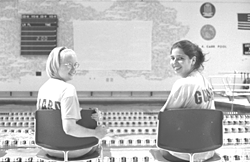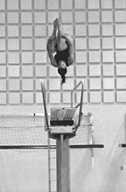

It's a hot summer day and you think to yourself that a nice dip in the pool would feel very cool and refreshing. So you put on your new sexy swimming apparel and hurry down to the nearest outdoor pool.
As you take your clothes off and lay down your towel you notice a hot piece of beef smiling at you from the side of the pool. In an attempt to be very impressive you do a little stretch to get the muscles loose and to show off your nicest body parts. Then you run to the edge of the water and jump into one of the highest and most impressive dives of your life.

You enter the water headfirst, like a pro, and slam your skull against the bottom. Distracted by beauty you didn't realize that the water near that area was only five feet deep and now you can't even figure out which way is up. Your eyes feel heavy and you're completely out of it, due to the massive concussion you've just suffered. Just as you're about to suck in water, you feel someone's arms around you, turning your head toward the surface. You don't know who it is, but you're thankful for your life. Suddenly you realize that the red blur you thought was your mommy is the lifeguard.
Lifeguards are those eyes in the sky that maintain safety at every pool, lake or ocean you attend. Their job is challenging, but times are changing and with the rapid growth in technology and the expansion of our society, today's lifeguards aren't what they use to be. This evolution can be seen and compared right here on campus with the various generations of certified guards.
"Becoming a lifeguard was a lot harder in those days," said Betsy Bruce, Oberlin's recreation director and a former lifeguard herself. Bruce comes from a family full of lifeguards beginning with her father, Robert Bruce. She proudly talked about her father's years teaching swimming at West Point from 1948 to 1964. "He use to tie their hands and legs behind their back and teach them to stay afloat for 30 minutes. It was called survival floating," said Bruce. "During World War II it was his job to train guys to get out of their parachutes in the water. Often when troops would parachute to a location they would land in the water and would have to know how to get out of their parachute before drowning." Robert Bruce moved on to become the athletic director for Wooster College here in Ohio after his time at West Point.
Her father and older brother's experiences as lifeguards inspired her to attain her certification in 1970 during her freshman year in high school. "Due to the lack of rescue equipment back then, we had to be skilled and strong enough swimmers to rescue the largest of individuals from the water," she said. "It was a very physically demanding class. The philosophy used to be life-saving and now it's more life-guarding and prevention."

"There are a lot of new techniques that lifeguards have to learn now that we were never taught," Bruce added. "Spinal injuries and how to handle them weren't even thought of. CPR has changed tremendously because of the advances in medical research. It used to be very mechanical and mouth to mouth or hands to chest. Now it's breathing though rescue masks for fear of disease and the use of many other medial technologies such as dephibulators," She also said that safety in general has changed because we are in a sue-happy world where a single mistake can ruin a career.
Bruce went on to explain that being a lifeguard was a more enviable position two decades ago because "being a lifeguard was being fit, trim, tanned and cool. No one thought about getting too much sun or skin cancer back then. It was also a pretty decent paying job." Even so, Bruce also stated emphatically that she would never lifeguard at a lake or ocean, even back then. "I will never work at an open waterfront or an oceanfront if I can help it," she said. "Those areas are way too stressful."
The job of a lifeguard can be very stressful at times, but it definitely still has it perks, as two Oberlin student lifeguards can attest to.
Deon Regis, a sophomore from Washington, D.C., decided to go for his license the summer after his junior year in high school. When I asked him why he was interested he replied, "I love to swim and I always liked the idea of being a lifeguard." He attended a lifeguard training school called Aloha in Maryland. "The first day we had to swim 500 meters doing five different strokes non stop. During our training we had to learn a lot of things. Some of which included different rescues, how to use a flotation device, how to deal with a spinal injury, community CPR and first aid."
All of this learning was packed into three long days, but ended with a license and the promise of many well-paid job opportunities. His first job was at an outdoor pool at a private apartment complex where he made nine dollars an hour. "There was a lot of pressure [then] because I was the only lifeguard on duty," he said. "There were always a lot of little kids in the pool. If anything happened no one was there to support me. I really had to know everything I was taught." To make things even tougher, Regis explained that too many lifeguards do not appreciate the responsibilities associated with their occupations. "A lot of lifeguards aren't serious about their job," he said.
Regis has found his working environment to be more enjoyable and efficient since coming to Ohio. "The lifeguards here are a lot more professional then what I've seen outside of Oberlin," he said. "You really don't have to worry here since most of the swimmers here are older and you have one or two more lifeguards on duty to support you in case of an emergency."
Kasi Chakravartula, a sophomore from Oakland, Calif., became certified last spring here at the Kendall Retirement Center in Oberlin. When I asked why she wanted to be a lifeguard, she said that the job "pays well and I love to work with the kids around my neighborhood. My first job was at an outdoor pool where a lot of the kids from Oakland come to swim. "Here training was over a 30-day period but her class only met on Mondays," said Chakravartula.
Betsy Bruce now teaches a lifeguard training class here at Oberlin. "As I train lifeguards now they have to be able to assess themselves," she said. "They may not make a rescue based on the situation. It becomes a moral decision."
Bruce's prerequisites for the class include the ability to swim 20 laps continuously, to fetch a brick from the bottom of a pool 13 feet deep and to swim 15 yards underwater. The class consists of 42 hours of work (a full semester course). Currently the class is full, but for those interested it will remain available for semesters to come.Times have changed and the job of a lifeguard has become less demanding than previous years, but it is still a job that requires you to stay alert and prepared at all times in case of an emergence. Lifeguarding isn't easy, but it can be very rewarding.
Like a guard over troubled water: Two lovely lifeguards take a break from their strenuous jobs - jobs that have become more and more difficult to get in recent years - to pose for a photo opportunity. (Staff photo)
Turn, turn, turn: 'Tis the season for swimming, diving and Marco Polo. (photo by Cory Mescon)
Copyright © 1999, The Oberlin Review.
Volume 128, Number 11, December 3, 1999
Contact us with your comments and suggestions.